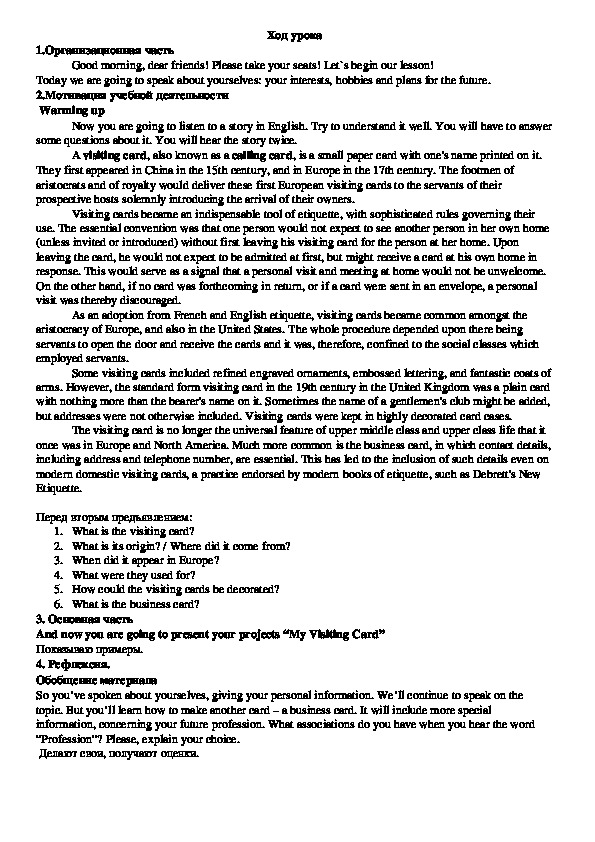1.Организационная часть
Ход урока
Good morning, dear friends! Please take your seats! Let`s begin our lesson!
Today we are going to speak about yourselves: your interests, hobbies and plans for the future.
2.Мотивация учебной деятельности
Warming up
Now you are going to listen to a story in English. Try to understand it well. You will have to answer
some questions about it. You will hear the story twice.
A visiting card, also known as a calling card, is a small paper card with one's name printed on it.
They first appeared in China in the 15th century, and in Europe in the 17th century. The footmen of
aristocrats and of royalty would deliver these first European visiting cards to the servants of their
prospective hosts solemnly introducing the arrival of their owners.
Visiting cards became an indispensable tool of etiquette, with sophisticated rules governing their
use. The essential convention was that one person would not expect to see another person in her own home
(unless invited or introduced) without first leaving his visiting card for the person at her home. Upon
leaving the card, he would not expect to be admitted at first, but might receive a card at his own home in
response. This would serve as a signal that a personal visit and meeting at home would not be unwelcome.
On the other hand, if no card was forthcoming in return, or if a card were sent in an envelope, a personal
visit was thereby discouraged.
As an adoption from French and English etiquette, visiting cards became common amongst the
aristocracy of Europe, and also in the United States. The whole procedure depended upon there being
servants to open the door and receive the cards and it was, therefore, confined to the social classes which
employed servants.
Some visiting cards included refined engraved ornaments, embossed lettering, and fantastic coats of
arms. However, the standard form visiting card in the 19th century in the United Kingdom was a plain card
with nothing more than the bearer's name on it. Sometimes the name of a gentlemen's club might be added,
but addresses were not otherwise included. Visiting cards were kept in highly decorated card cases.
The visiting card is no longer the universal feature of upper middle class and upper class life that it
once was in Europe and North America. Much more common is the business card, in which contact details,
including address and telephone number, are essential. This has led to the inclusion of such details even on
modern domestic visiting cards, a practice endorsed by modern books of etiquette, such as Debrett's New
Etiquette.
Перед вторым предъявлением:
1. What is the visiting card?
2. What is its origin? / Where did it come from?
3. When did it appear in Europe?
4. What were they used for?
5. How could the visiting cards be decorated?
6. What is the business card?
3. Основная часть
And now you are going to present your projects “My Visiting Card”
Показываю примеры.
4. Рефлексия.
Обобщение материала
So you’ve spoken about yourselves, giving your personal information. We’ll continue to speak on the
topic. But you’ll learn how to make another card – a business card. It will include more special
information, concerning your future profession. What associations do you have when you hear the word
“Profession”? Please, explain your choice.
Делают свои, получают оценки.

